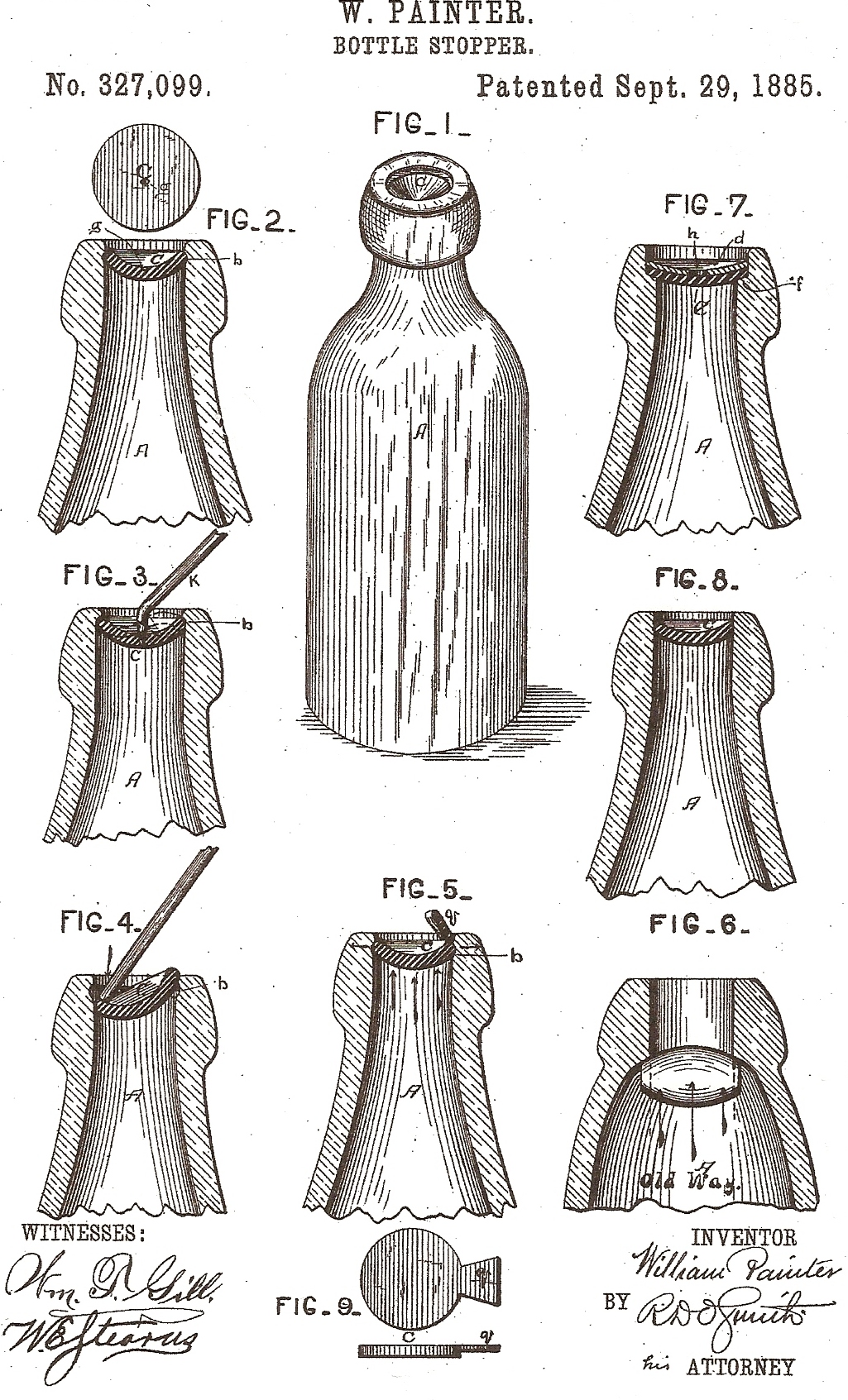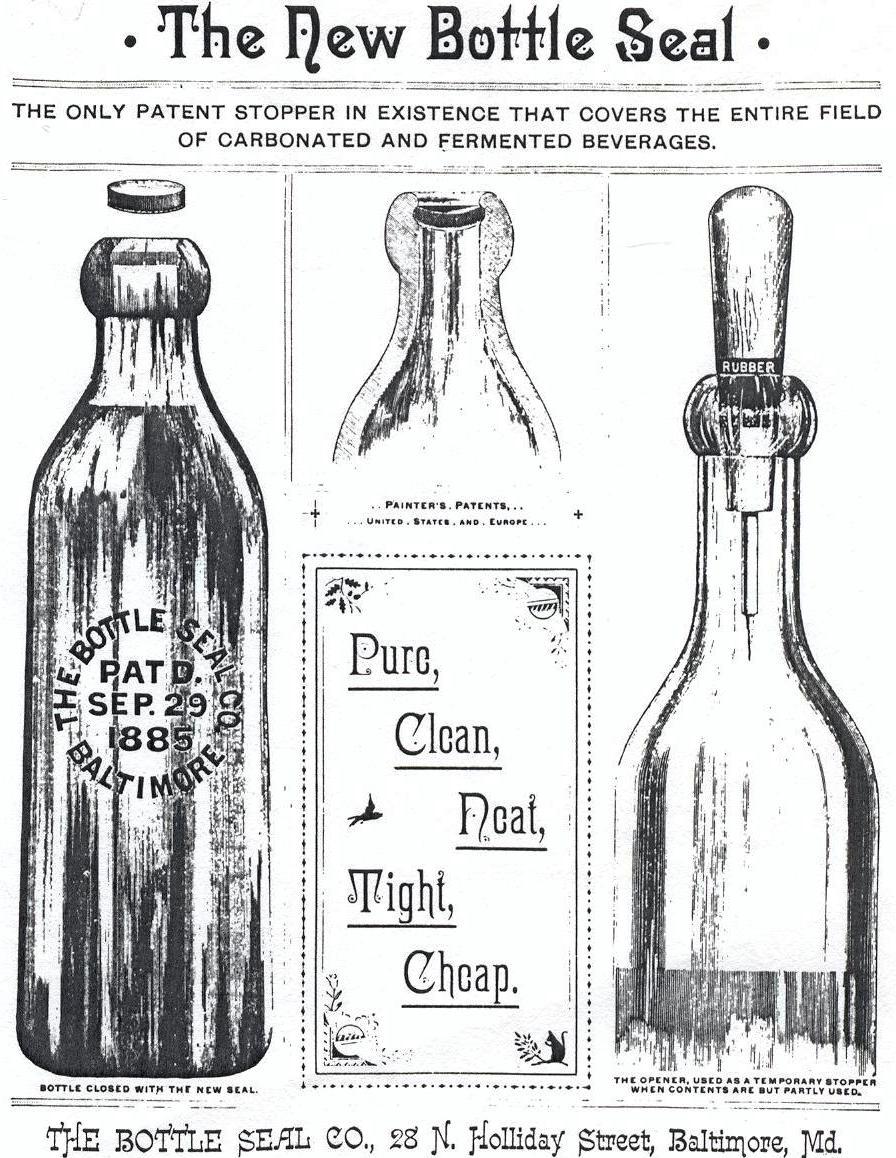William Painter Bottle Stopper

William
Painter’s patent application was filed June 5, 1885 and specified:
I, William Painter, of
Stoppers have heretofore been made secure against
internal pressure in one of two ways – by mechanical means exterior to
the bottle, as by using a tie-wire, also by special stopper-fasteners,
which have been made in large variety; or by placing the stopper inside
the bottle and so arranging it that the stopper is forced against a seat
or packing by the pressure within.
The first of these methods is objectionable because of
the expense, and in some cases the inconvenience of its use and
liability of accidental opening.
The second is so for the same reasons, and for the additional one
that the presence of the stopper inside of the bottle is an obstruction
to ready and effectual cleansing both of the bottle and stopper.
Stoppers secured by external fastenings are retained solely by
the power of the device to overcome the internal pressure.
Those within the bottle are retained because they present a solid
mass too large to pass through the bottle-neck.
In neither case referred to does the lateral expansion of the
stopper itself against the interior of the bottle-mouth enter as an
element of its action in resisting internal pressure, as it does with
stoppers made according to my method.
My invention differs from all others in the respects
named. It is made of thin
material, and placed within the bottle neck or mouth in cup-shaped form,
with its convex side inward, so that it presents the resistance of an
inverted arch or dome having its haunches supported by contact with the
walls of the bottle-mouth, which are preferably indented or grooved to
afford a more secure hold.
Pressure upon an arch is always transferred in part as lateral pressure
against its abutment, while a similar pressure upon a solid body having
the same convexity does not tend to displace the abutment laterally, but
to shear off the edges of such solid body.
This physical principle illustrates the actual difference between
my cup-shaped disk-stoppers and all others with which I am acquainted.
In the accompanying drawings, Figure 1 is a
perspective of an ordinary bottle with my stopper inserted.
Fig. 2 is a vertical section of the bottle neck and stopper.
Figs. 3 and 4 show methods of removing the stopper.
Figs. 5 and 6 illustrate the difference in action between my
inverted-arch stopper and an ordinary internal stopper.
Figs. 7, 8, and 9 are modifications of the invention.
A is an ordinary
bottle with a slight internal groove,
b, within the neck near the
top, and C is the
disk-stopper in place. I
prefer to provide the bottle-neck with a groove, because it makes the
action of the stopper sure, notwithstanding the usual internal variation
is sizes of necks incident to the manufacture of bottles, and also of
any variations there may be in the material from which the disk-stoppers
may be made, but the groove need not be more than one-sixty-fourth of an
inch in depth. Were it
practical to secure uniformity in the respects named, the groove would
not be required, and it may be dispensed with, as shown in Figs. 7 and
8. With comparatively low
internal pressure the groove is not necessary in any case.
The stopper C
is a circular disk of some suitable flexible material.
It may be normally somewhat concave, but the flat form answers
the purpose best. The disk
is made considerably larger than the neck of the bottle, so that when it
is forced therein its edges are contracted and it assumes the form of an
inverted arch or dome supported by pressure against the internal walls
of the bottle-neck…and will cause the resistance of the stopper to
increase measurably in proportion to the pressure upon it up to that
point at which the arch will be crushed.
If the stopper is made from material having
considerable resilience or inherent expansive force, or if the interior
of the bottle-mouth be roughened, sufficient adhesion will result
without the use of a groove to secure the initial hold…
For general purposes two-ply rubber packing of common
quality answers well for making the disks.
The material known as “linoleum” (made principally of ground
cork) also serves an excellent purpose, and is still cheaper than rubber
packing. Many other
materials, metallic as well as non-metallic, are available…Metal disks
require great strength of bottle-neck to avoid breaking, and are
therefore not considered as desirable…
To remove my disk-stoppers, a simple wire hook,
k, as shown in Fig. 3, may be
employed. The point pierces
the disk and either forcibly reverses the arch or lifts up one edge,
thereby releasing the disk.
To facilitate the piercing of the disk, a pit or cavity,
g, extending part way through
the disk may be employed.
By simply applying pressure against one edge of the disk, so as to force
it inward and tilt or partially rotate it, its hold is released, when
the internal pressure causes it to fly out.
This action is shown in Fig. 4…
When a groove in the bottle-neck is employed, the
concave form shown in Fig. 2 is preferred…
It is sometimes desirable to remove the disk-stopper
from the bottle without the use of a tool.
In such cases I form the disks with a lug or ear,
q.
(Shown in Figs. 5 and 9.)
A slight pull on the ear starts the disk from its position, and
it is thus easily removed.
I may also attach to the disk an eye of wire, like the shank of a
button, or a string, cord, or other device to facilitate its removal;
but for general use the simple circular disk is preferred…
By my method of sealing bottles against internal
pressure, as described, I am enabled to produce stoppers with the least
possible quantity of material, and that of a very cheap kind.
The stoppers require simply to be cut from a sheet by a hollow
punch or a punch and die.
They can therefore be produced at a small portion of the cost of any
other stopper I have knowledge of, and require no fastenings of any
kind, as they are self-retaining.
They are easily and quickly extracted, are neat in appearance,
and leave the bottle and its mouth entirely clear of all obstructions.
A great saving of bottles results from the use of my
disk-stoppers. They are
extremely cheap, and when bottles are lost or broken the cost of the
bottles alone is sacrificed, which is not the case when any of the usual
forms of fastening are employed.
Moreover, by reason of the uniformity of the material employed a
perfectly tight seal is always secured, and the contents of the bottle
cannot become flat.
Comments:
William Painter’s “Bottle Seal” patent (commonly
referred to as the “Baltimore Loop Seal”) is included in this review
because his particularly well-written specifications detail the
engineering principles supporting the stopper’s functionality.
Included are several clues portending the success he would
ultimately achieve with his Crown Closure.
Although they are often confused with
Baltimore Loop Seals were successfully marketed to
bottlers across
the North American continent who utilized them for bottles containing
"still" beverages, such as beer. They were not adopted
for the bottling of carbonated beverages such as soda and mineral water.
The accompanying 1886 Bottle Seal Company
National Bottlers’ Gazette
advertisement nicely illustrates how the stopper worked.
Note the rubber-handled “opener, used as a temporary stopper when
contents are but partly used.”

For additional information about Baltimore Loop Seals, visit Bill Lindsey's Historic Glass Bottle Identification & Information Website. In addition to Bill's very descriptive material, note the posted link to a well-written, "e-published" article entitled "William Painter's Baltimore Loop Seal" co-authored by Bill Lockhart, Tod von Mechow, Beau Schriever, David Whitten, Bill Lindsay, and Carol Serr. Here's a link to the Baltimore Loop Seal portion of the Historic Bottle Website:
 HutchBook.com
HutchBook.com